-
Engine3.5L V6
-
Power280 HP / 262 LB-FT
-
Transmission9-Speed Automatic
-
0-60 Time7.5 Seconds (est)
-
DrivetrainAll-Wheel Drive
-
Engine PlacementFront
-
Curb Weight4,317 LBS
-
Towing2,000 LBS
-
Seating2+2+3
-
Cargo82.1 CU-FT (max)
-
MPG20 City / 27 HWY
-
Base Price$29,995
-
As Tested Price$46,420
For all it had going for it, the second-generation Honda Pilot was stung by one undeniable fact: it looked like a big, boxy SUV at a time when consumer favor was shifting towards car-based crossovers. For 2016, though, Honda is offering a third-generation Pilot that not only does away with the old model's brutalist looks, but also adopts bleeding-edge safety technology and fuel-efficient powertrains.
The Pilot's new styling still doesn't really work, to our eyes. That's not because of the CR-V-inspired headlights or Accord-derived grille. It's not even because of the horizontally oriented, reshaped taillights. The biggest problem with the Pilot is its profile. The hood is an inch lower for 2016, and the CUV is 3.5 inches longer than its predecessor with an extra inch ahead of the front axle. Simply put, the proportions are out of whack. The hood is too short, the passenger compartment too large, and the beltline too low. It's little wonder then that both Autoblog staffers and readers have pointed out the 2016 Pilot's minivan-like resemblance.
Changes underneath the Pilot's sheetmetal are just as drastic. Honda incorporated a mix of high-strength steel, aluminum, and even magnesium to create the CUV's new bones. Taken as a whole, our top-of-the-line Elite tester is 286 pounds lighter than the previous model, while being 25 percent more rigid overall.


Aside from some penny pinching in the cabin – the hard plastic on the top of the rear door panels is particularly egregious – the Pilot's interior is home to soft-touch plastics, quality leather, and handsome piano black accents. Front passengers are treated to broad, comfortable, power seats, complete with heating and ventilation (depending on trim). What they lack in outright support through the turns, they make up for in long-haul comfort.
Honda will continue to sell the Pilot with seating for eight, but for the very first time, it's also offering a pair of captain's chairs in place of the second-row bench. Either setup is comfortable, though the seven-passenger layout allows easier access to the third row. As for the way-back, it can accommodate two kids or two adults in a pinch, but we aren't sure how Honda thinks three humans of any size will fit back there.
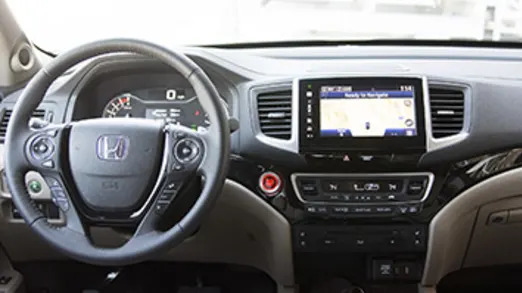

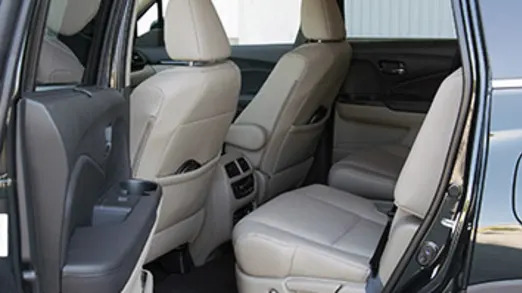
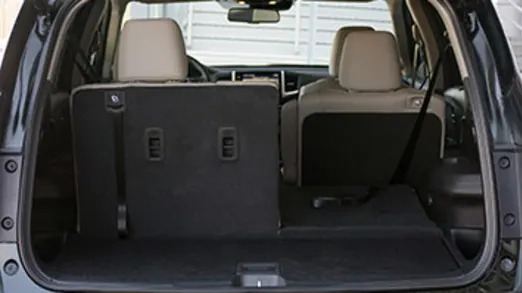
Happily, Honda ditched the two-screen center stack setup found elsewhere in its model range. The Pilot's ample eight-inch display (standard on the Touring and Elite trims) has menus that are easy to manage. A version of the Android operating system and Garmin navigation make up a pleasing software suite. That said, the touch-capacitive controls that sit on the driver's side of the display aren't very responsive, and when combined with the lack of haptic feedback, left us wondering if the 'buttons' had even registered our inputs.
There's an additional 4.2-inch display in the instrument cluster that replaces the analog speedometer – that's right, the digital speedo is all you get. Flanked by the counter-rotating needles of the tachometer, fuel, and temperature gauges, the screen displays everything from trip info to the current setting of the Intelligent Traction Management system. But screen real estate is only the most obvious display of tech in the Pilot – there's more electronic voodoo hiding under the skin. The infotainment system has a pair of fascinating new features: the DVR-like Tune Start and the playlist-creating Tune Mix, for the SiriusXM satellite radio.
The Honda Sensing system provides a comprehensive suite of computer-controlled nannies designed to keep things copacetic while driving. Road Departure Mitigation is a Honda first and works with the lane departure warning system to keep distracted drivers from straying off the road. Rather than relying on audio and visual driver alerts, RDM will actively apply steering and braking power as needed. It works like a dream.
Like the old Pilot, the only engine on offer is a 3.5-liter V6. But it's a new powerplant, hailing from Honda's Earth Dreams family. The engine puts out 280 horsepower and 262 pound-feet of torque, up from the outgoing engine's 250 hp and 253 lb-ft. With a drive-by-wire throttle, direct injection, a stop-start system, active engine mounts, and the latest version of Honda's variable cylinder management system, this is a far more advanced engine than the Pilot's old V6. The end result is a crossover that feels potent. Power is ample throughout the rev range. On top of that, the new electric throttle is sharp, responsive, and easy to modulate.
Beyond performance, the engine exudes a sense of refinement. It's quiet when cruising, but when it does start to sing, its note is smooth and sonorous. Honda added active engine mounts in a bid to quell any NVH issues in everyday driving and from the start-stop system. It works, eliminating any unpleasantries.
For base models, a six-speed automatic transmission takes the place of the Pilot's old five-speed unit. But a ZF-built nine-speed auto is featured on the top-end Touring and Elite trims. The nine-speed is responsive off the line, though its emphasis is on smooth shifts, not quick ones. We appreciate the transmission's willingness to hold gears on the many inclines we experienced on our drive through Kentucky hill country. But there's too much hunting on downshifts. Dig into the throttle and after a momentary pause the transmission serves up a lower gear, only to realize that it has several other cogs at its disposal, meaning a second, seemingly unnecessary gear-change happens shortly thereafter. The Pilot's paddle shifters are small relative to the size of the wheel, but have a clicky action that feels surprisingly sporty, considering the vehicle.
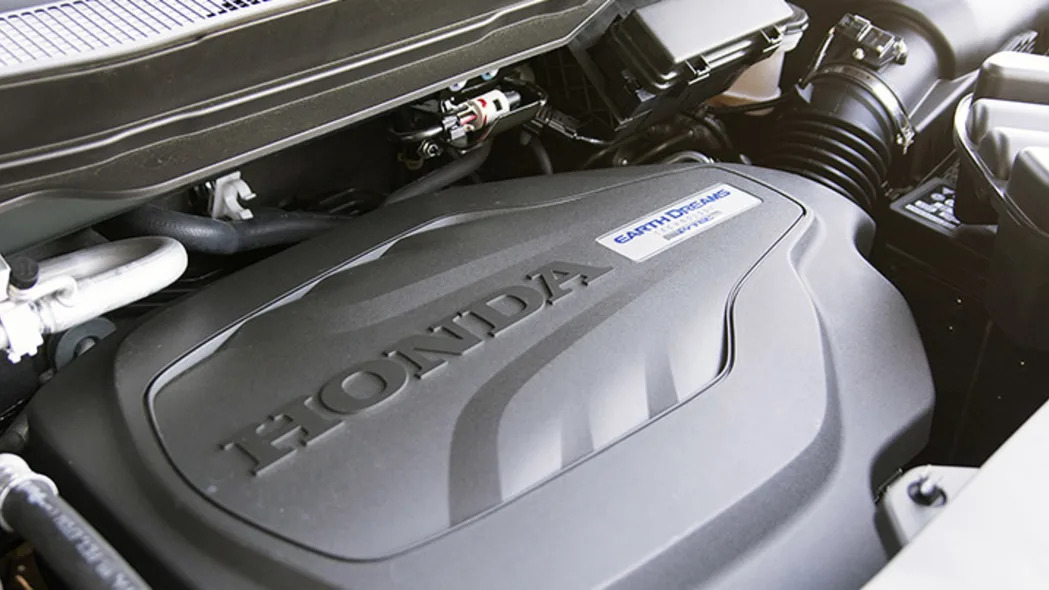
The nine-speed auto feeds power to an all-new, torque-vectoring all-wheel-drive system with an electronically controlled rear differential. According to Honda, the new Intelligent Variable Torque Management system can not only shift up to 70 percent of the engine's oomph to the rear axle, but it is also able to move torque laterally. It seems fine on flat, dry pavement, but we'll have to get the Pilot off the beaten path to see how this system fares in rugged conditions.
Honda is claiming best-in-class fuel economy in the two-wheel drive model, with a predicted 20 miles per gallon in the city and 27 mpg on the highway in two-wheel drive. All-wheel drive drops both figures by a single unit.
The comprehensive Pilot overhaul extends well past the powertrain. Front struts with amplitude-reactive dampers and an all-new multi-link rear suspension with coilover dampers underpin the Honda. The handling is exactly as you'd expect of a family oriented three-row CUV – soft and portly. However, our curvy, dynamic drive route through Kentucky didn't do the Pilot Elite any favors. These twisty roads better accentuated the 4,300-pound curb weight rather than the nearly 300-pound weight loss.
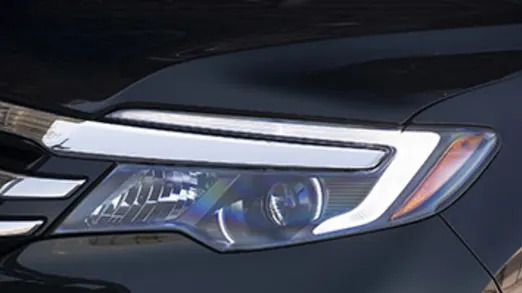

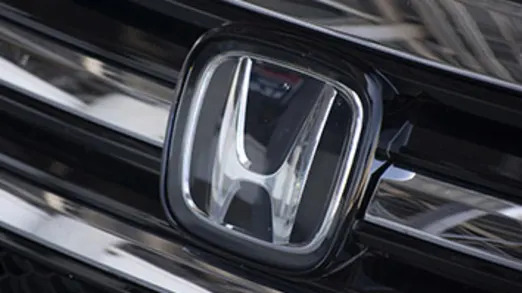
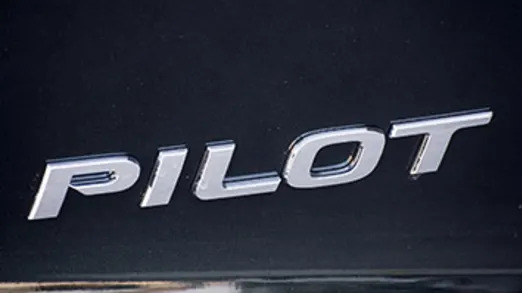
Honda's electric power steering is more or less par for the course. It's tight for a large crossover, with a 16:1 ratio and just over three turns from lock to lock, but we found ourselves working the tiller a bit more than we'd like. Tiny corrections are necessary, due to the lack of feedback through the wheel.
The Pilot rolls through the bends and dives under hard braking, neither of which come on progressively. But the Pilot hardly felt sloppy. Besides, the vast majority of consumers will never come close to pushing the big Honda as hard as we did during our drive route. For the families buying a Pilot, it's as agile as it needs to be.
Far more important to consumers is the way the Pilot rides. It's comfortable in the city and on the highway, even with our Elite model's 20-inch wheels. Small pavement imperfections are soaked up easily. Kentucky's smooth roads are a blessing, but we wonder if the Pilot won't feel a bit rougher once we get it out on the choppy roads of Detroit.

Prices for the 2016 Pilot start reasonably enough, at $29,995, plus $880 for destination. That's within $1,000 of both the pricier Explorer and the more affordable Pathfinder. Adding all-wheel-drive increases the price by $1,800, regardless of trim. There are a spate of trims to choose from, starting at the base LX, then building through the EX and EX-L – both of which feature sub trims that add additional equipment – and into Touring and the top-of-the-line Elite. We drove the most expensive model, the $46,420 Elite. That's slightly more dear than a loaded Pathfinder ($45,685), but significantly less than a fully optioned Ford Explorer Limited with the 2.3-liter EcoBoost. The Pilot Elite is pricey, but not extravagantly so.
Honda has built a thoroughly modern three-row crossover that won't only perform well in its class, but will probably steal at least a few sales from more premium vehicles – think Acura MDX and Infiniti QX60. The Pilot's smooth ride, handsomely appointed interior, high-tech safety systems, and efficient powertrain will play well with a range of customers. Most importantly, though, the Pilot will be highly appealing to value-minded families, perhaps more than ever before.
The Pilot's new styling still doesn't really work, to our eyes. That's not because of the CR-V-inspired headlights or Accord-derived grille. It's not even because of the horizontally oriented, reshaped taillights. The biggest problem with the Pilot is its profile. The hood is an inch lower for 2016, and the CUV is 3.5 inches longer than its predecessor with an extra inch ahead of the front axle. Simply put, the proportions are out of whack. The hood is too short, the passenger compartment too large, and the beltline too low. It's little wonder then that both Autoblog staffers and readers have pointed out the 2016 Pilot's minivan-like resemblance.
Changes underneath the Pilot's sheetmetal are just as drastic. Honda incorporated a mix of high-strength steel, aluminum, and even magnesium to create the CUV's new bones. Taken as a whole, our top-of-the-line Elite tester is 286 pounds lighter than the previous model, while being 25 percent more rigid overall.


Aside from some penny pinching in the cabin – the hard plastic on the top of the rear door panels is particularly egregious – the Pilot's interior is home to soft-touch plastics, quality leather, and handsome piano black accents. Front passengers are treated to broad, comfortable, power seats, complete with heating and ventilation (depending on trim). What they lack in outright support through the turns, they make up for in long-haul comfort.
Honda will continue to sell the Pilot with seating for eight, but for the very first time, it's also offering a pair of captain's chairs in place of the second-row bench. Either setup is comfortable, though the seven-passenger layout allows easier access to the third row. As for the way-back, it can accommodate two kids or two adults in a pinch, but we aren't sure how Honda thinks three humans of any size will fit back there.




Happily, Honda ditched the two-screen center stack setup found elsewhere in its model range. The Pilot's ample eight-inch display (standard on the Touring and Elite trims) has menus that are easy to manage. A version of the Android operating system and Garmin navigation make up a pleasing software suite. That said, the touch-capacitive controls that sit on the driver's side of the display aren't very responsive, and when combined with the lack of haptic feedback, left us wondering if the 'buttons' had even registered our inputs.
There's an additional 4.2-inch display in the instrument cluster that replaces the analog speedometer – that's right, the digital speedo is all you get. Flanked by the counter-rotating needles of the tachometer, fuel, and temperature gauges, the screen displays everything from trip info to the current setting of the Intelligent Traction Management system. But screen real estate is only the most obvious display of tech in the Pilot – there's more electronic voodoo hiding under the skin. The infotainment system has a pair of fascinating new features: the DVR-like Tune Start and the playlist-creating Tune Mix, for the SiriusXM satellite radio.
The Honda Sensing system provides a comprehensive suite of computer-controlled nannies designed to keep things copacetic while driving. Road Departure Mitigation is a Honda first and works with the lane departure warning system to keep distracted drivers from straying off the road. Rather than relying on audio and visual driver alerts, RDM will actively apply steering and braking power as needed. It works like a dream.
Like the old Pilot, the only engine on offer is a 3.5-liter V6. But it's a new powerplant, hailing from Honda's Earth Dreams family. The engine puts out 280 horsepower and 262 pound-feet of torque, up from the outgoing engine's 250 hp and 253 lb-ft. With a drive-by-wire throttle, direct injection, a stop-start system, active engine mounts, and the latest version of Honda's variable cylinder management system, this is a far more advanced engine than the Pilot's old V6. The end result is a crossover that feels potent. Power is ample throughout the rev range. On top of that, the new electric throttle is sharp, responsive, and easy to modulate.
Beyond performance, the engine exudes a sense of refinement. It's quiet when cruising, but when it does start to sing, its note is smooth and sonorous. Honda added active engine mounts in a bid to quell any NVH issues in everyday driving and from the start-stop system. It works, eliminating any unpleasantries.
For base models, a six-speed automatic transmission takes the place of the Pilot's old five-speed unit. But a ZF-built nine-speed auto is featured on the top-end Touring and Elite trims. The nine-speed is responsive off the line, though its emphasis is on smooth shifts, not quick ones. We appreciate the transmission's willingness to hold gears on the many inclines we experienced on our drive through Kentucky hill country. But there's too much hunting on downshifts. Dig into the throttle and after a momentary pause the transmission serves up a lower gear, only to realize that it has several other cogs at its disposal, meaning a second, seemingly unnecessary gear-change happens shortly thereafter. The Pilot's paddle shifters are small relative to the size of the wheel, but have a clicky action that feels surprisingly sporty, considering the vehicle.

The nine-speed auto feeds power to an all-new, torque-vectoring all-wheel-drive system with an electronically controlled rear differential. According to Honda, the new Intelligent Variable Torque Management system can not only shift up to 70 percent of the engine's oomph to the rear axle, but it is also able to move torque laterally. It seems fine on flat, dry pavement, but we'll have to get the Pilot off the beaten path to see how this system fares in rugged conditions.
Honda is claiming best-in-class fuel economy in the two-wheel drive model, with a predicted 20 miles per gallon in the city and 27 mpg on the highway in two-wheel drive. All-wheel drive drops both figures by a single unit.
The comprehensive Pilot overhaul extends well past the powertrain. Front struts with amplitude-reactive dampers and an all-new multi-link rear suspension with coilover dampers underpin the Honda. The handling is exactly as you'd expect of a family oriented three-row CUV – soft and portly. However, our curvy, dynamic drive route through Kentucky didn't do the Pilot Elite any favors. These twisty roads better accentuated the 4,300-pound curb weight rather than the nearly 300-pound weight loss.




Honda's electric power steering is more or less par for the course. It's tight for a large crossover, with a 16:1 ratio and just over three turns from lock to lock, but we found ourselves working the tiller a bit more than we'd like. Tiny corrections are necessary, due to the lack of feedback through the wheel.
The Pilot rolls through the bends and dives under hard braking, neither of which come on progressively. But the Pilot hardly felt sloppy. Besides, the vast majority of consumers will never come close to pushing the big Honda as hard as we did during our drive route. For the families buying a Pilot, it's as agile as it needs to be.
Far more important to consumers is the way the Pilot rides. It's comfortable in the city and on the highway, even with our Elite model's 20-inch wheels. Small pavement imperfections are soaked up easily. Kentucky's smooth roads are a blessing, but we wonder if the Pilot won't feel a bit rougher once we get it out on the choppy roads of Detroit.

Prices for the 2016 Pilot start reasonably enough, at $29,995, plus $880 for destination. That's within $1,000 of both the pricier Explorer and the more affordable Pathfinder. Adding all-wheel-drive increases the price by $1,800, regardless of trim. There are a spate of trims to choose from, starting at the base LX, then building through the EX and EX-L – both of which feature sub trims that add additional equipment – and into Touring and the top-of-the-line Elite. We drove the most expensive model, the $46,420 Elite. That's slightly more dear than a loaded Pathfinder ($45,685), but significantly less than a fully optioned Ford Explorer Limited with the 2.3-liter EcoBoost. The Pilot Elite is pricey, but not extravagantly so.
Honda has built a thoroughly modern three-row crossover that won't only perform well in its class, but will probably steal at least a few sales from more premium vehicles – think Acura MDX and Infiniti QX60. The Pilot's smooth ride, handsomely appointed interior, high-tech safety systems, and efficient powertrain will play well with a range of customers. Most importantly, though, the Pilot will be highly appealing to value-minded families, perhaps more than ever before.
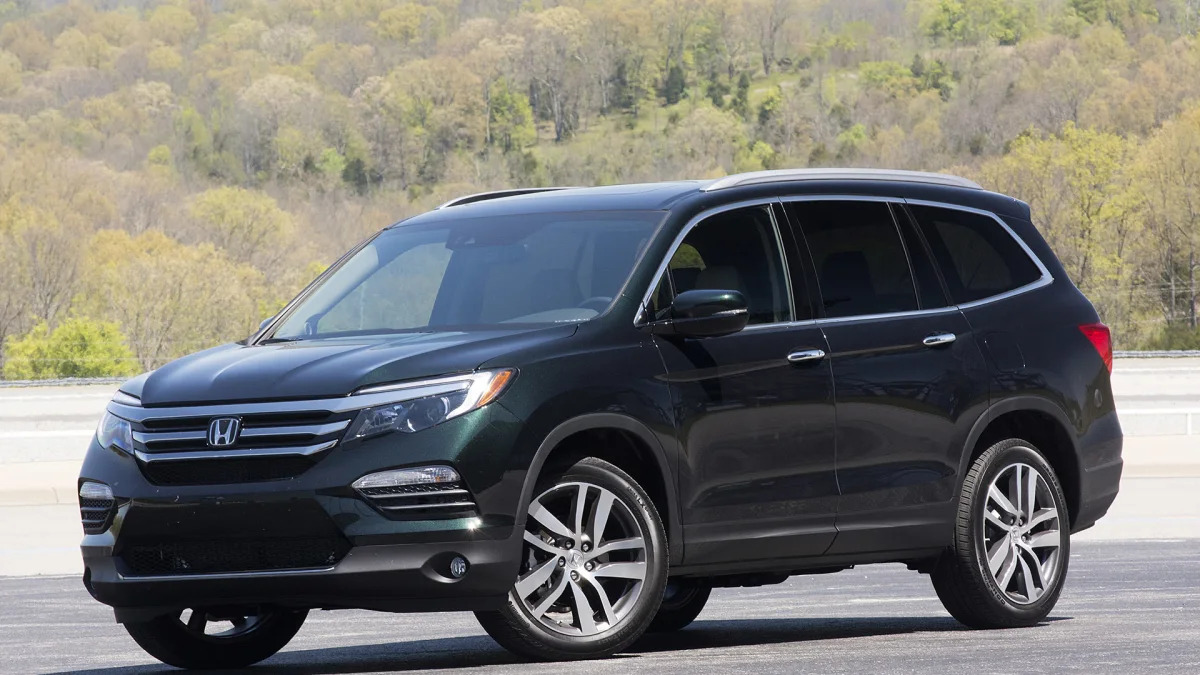










Sign in to post
Please sign in to leave a comment.
Continue